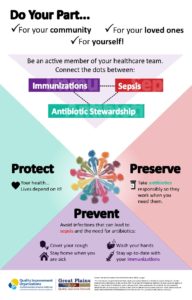
Hats, mittens, cough drops and Kleenex become common shopping list items as the winter season approaches. Protection against the cold and supplies to fight a cold seem to be connected. Infections are a growing health concern and the Great Plains Quality Innovation Network (QIN) is Connecting the Dots among antibiotics, immunizations and sepsis to improve health outcomes.
 “When we’re sick, we often think we need antibiotics to fight the infection so we can feel better,” commented Krystal Hays, DNP, RN, RAC-CT, regional project manager at Great Plains QIN. “In reality, taking antibiotics for illnesses caused by viruses, such as a cold or the flu, does more harm than good.”
“When we’re sick, we often think we need antibiotics to fight the infection so we can feel better,” commented Krystal Hays, DNP, RN, RAC-CT, regional project manager at Great Plains QIN. “In reality, taking antibiotics for illnesses caused by viruses, such as a cold or the flu, does more harm than good.”
Antimicrobial resistance is one of the top ten global public health threats facing humanity, according to the World Health Organization. Antibiotic Awareness Week November 18-24, 2021, is observed annually to raise awareness of the threat of antibiotic resistance and the importance of appropriate antibiotic use.
The Center for Disease Control and Prevention’s (CDC) Be Antibiotics Aware toolkit provides up-to-date resources to increase awareness and help improve human antibiotic prescribing and use in the United States.
Great Plains QIN joins the effort with the Connecting the Dots to promote the three “P”s for improved health outcomes: protecting one’s health, preserving antibiotic effectiveness, and preventing infection from leading to sepsis through immunizations, health hygiene, and responsible antibiotic use.
Facts to Connect the Dots
- Every year 2.8 million people get an antibiotic-resistant infection and more than 35,000 people die.1
- Approximately 47 million unnecessary antibiotics are prescribed for infections, such as colds and the flu.2
- Approximately 50,000 American adults died annually from vaccine-preventable infections, prior to COVID-19.3
- Some adult routine vaccinations decreased as much as 95% during the COVID-19 pandemic.4
- 87% of patients with sepsis had symptoms prior to hospitalization.5
- One in three patients who die in a hospital has sepsis.5
 Hays explained, “Bacteria can become resistant to antibiotics and continue to multiply in the body, making life-threatening illnesses more difficult, or even impossible, to treat. Staying up-to-date with immunizations to prevent illness and only taking antibiotics when needed are ways that we can protect our health.”
Hays explained, “Bacteria can become resistant to antibiotics and continue to multiply in the body, making life-threatening illnesses more difficult, or even impossible, to treat. Staying up-to-date with immunizations to prevent illness and only taking antibiotics when needed are ways that we can protect our health.”
Anyone can get an infection that leads to sepsis, which is the body’s overwhelming and life-threatening infection response that can lead to tissue damage, organ failure, and death. Preventing and properly treating sepsis is a community issue that will require collaboration between all care settings: hospitals, nursing homes, home health, physician clinics, and more.
“We can protect our health and preserve antibiotics for conditions, such as sepsis, where antibiotics are a life-saving treatment,” Hays continued. “The Connecting the Dots tools and resources can be shared with patients to increase their understanding of the connection between immunizations, antibiotics, and sepsis.”
Sources:
- Centers for Disease Control and Prevention (CDC) Drug Resistance (July 20, 2020)
- Centers for Disease Control and Prevention (CDC) Antibiotic Resistance (July 20, 2020)
- National Foundation for Infectious Diseases (NFID): Support Vaccination – Let Us Count the Ways (August 2, 2021 by NFIDi n National Immunization Awareness Month)
- National Foundation for Infectious Diseases (NFID); Issue Brief – The Impact of COVID-19 on US Vaccination Rates (Published August 2020)
- Centers for Disease Control and Prevention (CDC) Get Ahead of Sepsis; (August 20, 2021)
* Originally featured in the Q Insider | Great Plains Quality Innovation Network – November 08, 2021 – Vol 2, Issue 11
